Hydraulic pressure switches | Suco

Adjustment range
Body
Diaphragm / Seal
Voltage
Contacts
Connection
Thread
Hysteresis
Other
Article number
Stock
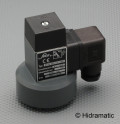
Adjustment range
0,1-1 bar (±0,1-0,2)
Body Ps
Aluminium
Diaphragm / Seal
NBR
Voltage
10-250 V AC/DC
Contacts
SPDT (changeover)
Connection
Connector
Thread
Int. G1/4
Hysteresis
Adjustable at factory
Other
-
Article number
< 5
Immediate
+Info
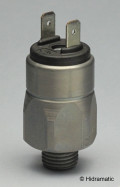
Adjustment range
0,1-1 bar (±0,2)
Body Ps
Zinc-plated steel
Diaphragm / Seal
NBR
Voltage
10-42 V AC/DC
Contacts
NO
Connection
Spade terminals (Faston)
Thread
Ext. G1/4
Hysteresis
Not adjustable
Other
-
Article number
> 20
Immediate
+Info

Adjustment range
0,1-1 bar (±0,2)
Body Ps
Zinc-plated steel
Diaphragm / Seal
NBR
Voltage
10-42 V AC/DC
Contacts
NO
Connection
Spade terminals (Faston)
Thread
Ext. G1/8
Hysteresis
Not adjustable
Other
-
Article number
< 5
Immediate
+Info

Adjustment range
0,1-1 bar (±0,2)
Body Ps
Zinc-plated steel
Diaphragm / Seal
NBR
Voltage
10-42 V AC/DC
Contacts
NO
Connection
Spade terminals (Faston)
Thread
Ext. M10x1 con.
Hysteresis
Not adjustable
Other
-
Article number
> 20
Immediate
+Info

Adjustment range
0,1-1 bar (±0,2)
Body Ps
Zinc-plated steel
Diaphragm / Seal
NBR
Voltage
10-42 V AC/DC
Contacts
NO
Connection
Spade terminals (Faston)
Thread
Ext. M12x1,5 cyl.
Hysteresis
Not adjustable
Other
-
Article number
< 20
Immediate
+Info

Adjustment range
0,1-1 bar (±0,2)
Body Ps
Zinc-plated steel
Diaphragm / Seal
NBR
Voltage
10-42 V AC/DC
Contacts
NO
Connection
Spade terminals (Faston)
Thread
Ext. NPT1/8
Hysteresis
Not adjustable
Other
-
Article number
< 5
Immediate
+Info

Adjustment range
0,1-1 bar (±0,2)
Body Ps
Zinc-plated steel
Diaphragm / Seal
NBR
Voltage
10-42 V AC/DC
Contacts
NO
Connection
Spade terminals (Faston)
Thread
Ext. G1/4
Hysteresis
Not adjustable
Other
Pmax 600 bar
Article number
< 10
Immediate
+Info
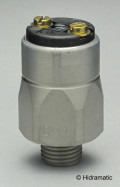
Adjustment range
0,1-1 bar (±0,2)
Body Ps
Zinc-plated steel
Diaphragm / Seal
NBR
Voltage
10-42 V AC/DC
Contacts
NO
Connection
Screw terminals
Thread
Ext. G1/4
Hysteresis
Not adjustable
Other
-
Article number
< 5
Immediate
+Info

Adjustment range
0,1-1 bar (±0,2)
Body Ps
Zinc-plated steel
Diaphragm / Seal
NBR
Voltage
10-42 V AC/DC
Contacts
NC
Connection
Spade terminals (Faston)
Thread
Ext. G1/4
Hysteresis
Not adjustable
Other
-
Article number
< 10
Immediate
+Info

Adjustment range
0,1-1 bar (±0,2)
Body Ps
Zinc-plated steel
Diaphragm / Seal
NBR
Voltage
10-42 V AC/DC
Contacts
NC
Connection
Spade terminals (Faston)
Thread
Ext. G1/8
Hysteresis
Not adjustable
Other
-
Article number
< 5
Immediate
+Info

Adjustment range
0,1-1 bar (±0,2)
Body Ps
Zinc-plated steel
Diaphragm / Seal
NBR
Voltage
10-42 V AC/DC
Contacts
NC
Connection
Spade terminals (Faston)
Thread
Ext. M10x1 con.
Hysteresis
Not adjustable
Other
-
Article number
< 5
Immediate
+Info

Adjustment range
0,1-1 bar (±0,2)
Body Ps
Zinc-plated steel
Diaphragm / Seal
NBR
Voltage
10-42 V AC/DC
Contacts
NC
Connection
Spade terminals (Faston)
Thread
Ext. M12x1,5 cyl.
Hysteresis
Not adjustable
Other
-
Article number
< 5
Immediate
+Info

Adjustment range
0,1-1 bar (±0,2)
Body Ps
Zinc-plated steel
Diaphragm / Seal
NBR
Voltage
10-42 V AC/DC
Contacts
NC
Connection
Spade terminals (Faston)
Thread
Ext. NPT1/8
Hysteresis
Not adjustable
Other
-
Article number
< 5
Immediate
+Info

Adjustment range
0,1-1 bar (±0,2)
Body Ps
Zinc-plated steel
Diaphragm / Seal
NBR
Voltage
10-42 V AC/DC
Contacts
NC
Connection
Spade terminals (Faston)
Thread
Ext. G1/4
Hysteresis
Not adjustable
Other
Pmax 600 bar
Article number
< 5
Immediate
+Info
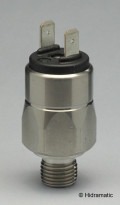
Adjustment range
0,1-1 bar (±0,2)
Body Ps
Stainless steel
Diaphragm / Seal
NBR
Voltage
10-42 V AC/DC
Contacts
NC
Connection
Spade terminals (Faston)
Thread
Ext. G1/4-E
Hysteresis
Not adjustable
Other
Pmax 600 bar
Article number
< 5
Immediate
+Info

Adjustment range
0,1-1 bar (±0,2)
Body Ps
Zinc-plated steel
Diaphragm / Seal
NBR
Voltage
10-42 V AC/DC
Contacts
NC
Connection
Screw terminals
Thread
Ext. G1/4
Hysteresis
Not adjustable
Other
-
Article number
< 5
Immediate
+Info
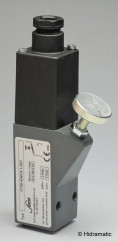
Adjustment range
0,2-2 bar (±0,2-0,3)
Body Ps
Aluminium
Diaphragm / Seal
NBR
Voltage
10-250 V AC/DC
Contacts
SPDT (changeover)
Connection
Connector
Thread
Int. G1/4
Hysteresis
Not adjustable
Other
Knurled screw
Article number
< 5
Immediate
+Info
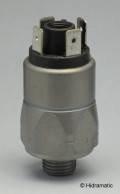
Adjustment range
0,3-1,5 bar (±0,2)
Body Ps
Zinc-plated steel
Diaphragm / Seal
NBR
Voltage
10-250 V AC/DC
Contacts
SPDT (changeover)
Connection
Spade terminals (Faston)
Thread
Ext. G1/4
Hysteresis
Adjustable at factory
Other
-
Article number
< 10
Immediate
+Info

Adjustment range
0,3-1,5 bar (±0,2)
Body Ps
Zinc-plated steel
Diaphragm / Seal
NBR
Voltage
10-250 V AC/DC
Contacts
SPDT (changeover)
Connection
Spade terminals (Faston)
Thread
Ext. M10x1 con.
Hysteresis
Adjustable at factory
Other
-
Article number
< 5
Immediate
+Info

Adjustment range
0,3-1,5 bar (±0,2)
Body Ps
Zinc-plated steel
Diaphragm / Seal
NBR
Voltage
10-250 V AC/DC
Contacts
SPDT (changeover)
Connection
Spade terminals (Faston)
Thread
Ext. M12x1,5 cyl.
Hysteresis
Adjustable at factory
Other
-
Article number
< 5
Immediate
+Info
